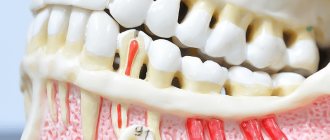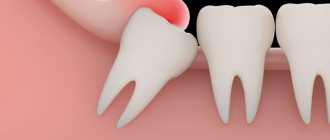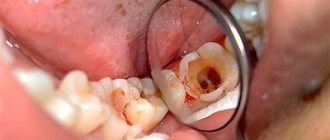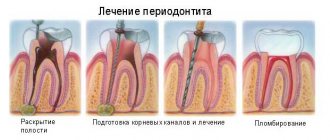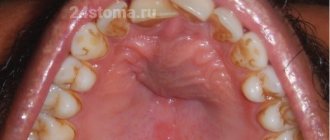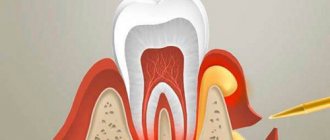Walking in the fresh air is useful at any time of the year, but still a long stay outside in sub-zero temperatures can sometimes unexpectedly lead to local hypothermia of the face and head. Often the consequence is an inflammatory process in the dental nerve.
In such cases, patients usually say that they “have caught a cold on the dental nerve.” Experts call this phenomenon “local hypothermia of the dental nerve.”
Inflammation in this case usually has nothing to do with the penetration of infection. The reason is directly related to the experience of severe hypothermia.
To understand the reason for the development of inflammation in the dental nerve after exposure to cold temperatures, you should first pay attention to the anatomy. The center of the tooth is the pulp.
The pulp is a soft tissue with its own system of blood vessels and nerves. It has a loose structure. Each pulp tissue performs a specific function. It is known that large nerves of the pulp have a connection with the root processes. If toothache occurs, it is always associated with the dental nerve in the pulp.
Why might this happen?
The reasons are obvious:
- Dental nerves are sensitive to cold.
- Prolonged exposure to wind on an unprotected face.
- Lack of headwear in cold weather.
- General hypothermia of the body.
Possible provoking factors should also be highlighted
- Development of caries.
- Tooth chips and injuries.
- Tooth infection.
- The use of low-quality fillings in dental treatment.
- Poor quality prosthetics.
Visiting the dentist if you have a cold
There is no consensus regarding the possibility of dental treatment for colds; doctors act according to the circumstances. For example, acute toothache is the basis for immediate treatment. In certain situations, the patient does not want to reschedule a visit to the doctor; clinic staff have the right to refuse to provide services in order to prevent infection of other patients.
Explanations from a qualified specialist will help you make the right decision and cancel your planned visit to the dentist. Dental treatment is accompanied by the risk of injury to the gums; wounds are a “road” for infection. In addition, painkillers can become a cause of deterioration of well-being during ARVI. A cough and runny nose are an obstacle to the dentist’s manipulations; the patient cannot stand it with his mouth open for a long time. Pauses have a negative impact on the quality of treatment; in addition, the possibility of infection of the doctor cannot be ruled out.
What symptoms indicate a cold dental nerve?
Pain. Local hypothermia of the dental nerve is manifested by severe pain. It usually occurs unexpectedly without any mechanical impact.
In some situations, patients complain of pain in the ear, jaw, and temples. With temperature and mechanical influence, such pain may intensify.
Heat . Not in all situations, but it still sometimes happens that the inflammatory process in the pulp after hypothermia leads to an increase in body temperature. Usually it rises to a maximum of 37.5° C. If the temperature is higher, this may indicate general intoxication of the body.
The appearance of skin sensitivity . Sometimes pronounced redness appears on the face in the area where the inflamed tooth is located, associated with increased sensitivity of the skin in this area.
Patients may complain not only of pain when touching a “chilled” tooth, but also to the skin of the face in the approximate area of its location.
Exceptional cases of dental treatment for colds
In certain situations, dental treatment for ARVI is inevitable. Often a cold is accompanied by the development of fluxes, which are a serious threat to the entire body. Pus is a real danger to the patient’s life; fluxes should be treated in the early stages to reduce the likelihood of negative consequences to a minimum. If possible, the doctor tolerates tooth extraction; an open wound is a favorable environment for the proliferation of bacteria and microbes; in addition, the healing process is delayed due to weakened immunity.
Viral diseases are accompanied by a feeling of weakness, headaches; patients take antipyretics and painkillers, which are not always compatible with drugs used in dentistry. The patient must inform the doctor about the medications he is taking.
The acute stage of a cold lasts on average 3-4 days, subject to the doctor’s recommendations, bed rest, and proceeds without complications. Both the patient and the doctor are interested in rescheduling a planned visit to the dental clinic. The patient recovers in comfortable conditions, medical workers are protected from bacteria and viruses. If it is impossible to postpone treatment, the specialist takes additional precautions and ventilates or quartzizes the room after the appointment.
If necessary, the dentist will provide assistance, for example, installing a temporary filling until the patient fully recovers. Often, after visiting the dentist during an acute respiratory viral infection, the patient experiences pain in the tooth area; the body’s reaction goes away after a few days. Periodic visits to the dental office are a rule that patients must follow, regardless of age or employment. Preventative dental examinations will eliminate the need to make a responsible decision during an exacerbation of a cold.
How to properly treat a chilled tooth nerve?
If the dental nerve is cold, you should not postpone a visit to the dentist, as the inflammatory process and pain will intensify over time, which will lead to dangerous negative consequences.
For temporary pain relief:
- Moisten a piece of sterile cotton wool with alcohol (another option is vodka) and apply it to the tooth. This will slightly suppress the inflammatory process and relieve pain. But it is important to avoid contact of the mucous membrane with the cotton wool to avoid burns.
- Add chlorhexidine (no more than 5 drops) to a glass of warm water from a kettle. The solution should be used to rinse the mouth to “pacify” inflammation.
- Use dried sage leaves in small quantities. Pour boiling water over them, let cool. After this, you can rinse your mouth with the resulting infusion.
Professional treatment
The treatment method for a cold dental nerve depends on the cause, the nature of the symptoms, the general well-being of the patient, the condition of the tooth, its pulp and oral mucosa. In case of severe complications, there is usually a need for urgent hospitalization of the patient.
If for now the symptoms are limited to acute pain, the dentist will provide emergency treatment to eliminate the inflammatory process.
If there are chips, other signs of mechanical damage to the tooth, or signs of caries, the diseased tooth is cleaned and filled.
In case of necrosis of the soft tissue of the pulp or its complete damage, surgical treatment and antibacterial therapy will be required after removal of the pulp.
Symptoms of dental nerve inflammation
What are the most common symptoms if the nerve has a cold:
- possible hypersensitivity of the eyes, eyelids and forehead;
- the occurrence of constant aching pain in the jaw area;
- the appearance of shooting pain;
- constant severe pain, which worsens when teeth come into contact with cold or hot food;
- it hurts to smile.
The inflammatory process during hypothermia of the dental nerve occurs from the penetration of pathogenic microflora into the pulp, which is the cause of shooting pains when there is a large temperature difference or during physical contact (pain when chewing).
If pathogenic processes develop very quickly or the patient delays visiting the dental clinic, then inflammation can spread beyond the damaged tooth in the form of swelling, which everyone is accustomed to calling “flux.” Its medical name is periostitis. The second possible complication is periodontal inflammation. Unlike flux, it does not have an external expression in the form of noticeable swelling and is not accompanied by purulent formations.
This cold, in which the dental nerve hurts, occurs equally in men and women. Therefore, when the question arises: “What to do if your tooth gets a cold?” or “Is it possible to catch a cold on the facial nerve?”, consult a doctor immediately so as not to get even more unpleasant complications.
If you do not do this as soon as possible, the inflammatory process will develop, and this can lead to the appearance of multiple purulent foci, and subsequently to the death of first the tissue, and then the dental nerves. Over time, severe pain stops, but inflammation continues, and the longer you postpone a visit to the hospital, the more difficult the treatment will be.
Reasons for the onset of the disease
If you regularly visit the dentist and pay enough attention to dental care, then most likely you are not in danger of developing inflammation of the dental nerve. But if you neglect the condition of your teeth, such a disease is not uncommon. There are several reasons that can trigger nerve inflammation:
- neglected and not cured in time caries, especially when the remote control is damaged;
- There are chips, injuries, and fractures on the teeth;
- with a previously acquired infection due to improper treatment;
- during previous treatment, low-quality materials or medications were used;
- When installing the prosthesis, the tooth was processed incorrectly;
- Perhaps the body, at this time, was weakened by another infectious disease.
Treatment at home
What to do if your nerve has already caught a cold, but you won’t be able to visit a doctor in the near future for some reason. Is it possible to treat a tooth without the help of a dentist, and most importantly, how to treat it?
The first step is to carry out antibacterial therapy, which will prevent the development of the inflammatory process. Next, you need to deal with pain relief if professional help is not available.
The main rule that must be observed when treating any foci of inflammation is that you cannot apply warm compresses and in general do not warm the site of inflammation. The most you can do is cover your cheek with a scarf.
The following drugs can be used for pain relief: coffedon, dexalgin, oxadol, lidocaine .
ethnoscience
There are many traditional ways to treat a tooth without expensive medications. All of them belong to the so-called alternative medicine, which uses herbs, fruits or other very accessible and inexpensive remedies.
- you can try rinsing with strong alcoholic drinks, preferably regular vodka, at room temperature;
- you can apply a compress of chopped onion wrapped in a thin cloth to the ear on the opposite side of the diseased tooth;
- very good results were shown by rinsing with a lukewarm soda solution or sage infusion (15 mg of sage per 200 mg of hot water, leave for 15 minutes, strain before use);
- crush a regular analgin tablet and apply it to the painful area, this relieves acute pain well;
- Salted lard was considered an excellent remedy for toothache. Apply a small slice of lard to the sore spot;
- many traditional healers advise using a cut clove of garlic, like lard, and applying it to the affected tooth;
- make a small cotton ball, soak it in alcohol and apply it to the sore spot, trying not to touch the gum, as long-term exposure to alcohol can cause a burn;
- dilute a few drops of Chlorhexidine in a glass of warm water and rinse your mouth with this solution at least three times a day;
- Another remedy is to chew a sorrel leaf;
- pour birch buds (25 g) with alcohol (100 g), leave for 10 days. Moisten a cotton ball with this tincture and place it on the sore tooth;
- cloves have long been considered an excellent remedy for toothache, so simply moisten a cotton ball with clove oil and apply it to the gum, and if there is an open cavity in the tooth, then put the cotton wool directly into it;
- Hydrogen peroxide has long become a popular component of many folk recipes, and in this case, rinsing with a solution of peroxide and water can effectively disinfect the oral cavity, stop inflammation and, as a bonus, remove plaque from teeth.
All these folk recipes will help relieve an attack of acute pain only for a short time, but will not solve the problem itself. Only a professional doctor will help you cure inflammation.
How to protect the dental nerve from hypothermia?
- During the cold season, use warm hats, scarves and outerwear with a high collar.
- In low temperatures and strong winds, it is advisable to cover your face with clothing.
- Do not use a thermos with hot water. Temperature changes may cause inflammation of the dental nerve and the appearance of an acute painful reaction.
Study the condition and appearance of your teeth, as well as the oral mucosa, regularly on your own. This way you can see suspicious changes in a timely manner.
Indications and contraindications
Doctors do not recommend treating or removing teeth for ARVI symptoms. The fact is that even the immunity of a healthy person does not always cope with protection. If the immune system is weakened by a cold, the likelihood of complications increases.
You can cancel a visit to the dentist in case of planned operations. In addition, during a cold you should not install an implant, remove tumors and wisdom teeth, or perform plastic surgery in the oral cavity in preparation for certain types of treatment.
However, a cold is not an absolute contraindication to dental procedures. If the disease is mild, then it is possible to take an impression to make dentures, remove tartar or bleach the enamel. Treatment is also carried out in emergency cases, when the cause of the pain can cause the development of serious complications, these include:
- odontogenic periostatitis in acute form;
- acute pain when cutting through the figure eight;
- periodontitis of a traumatic nature;
- inflammation of the mucous membrane;
- inflammation of the trigeminal nerve;
- periodontitis;
- phlegmon;
- abscess;
- injuries;
- abscess.
In such situations, you should consult your doctor. He will decide on an individual basis whether dental procedures should be carried out now or whether they can be postponed until the end of the illness.
What if the cause of the elevated temperature is not a cold?
Often, an increase in temperature can be associated with inflammatory diseases in the oral cavity. For example, a cyst could form in a tooth or gum - a cavity filled with fluid. And elevated temperature is nothing more than the body’s reaction to protect itself from the spread of infection.
In an advanced state, the cyst affects neighboring teeth, so if you notice such symptoms, you need to consult a dentist.
By the way, a dental cyst is diagnosed using an x-ray - this is one of the reasons why it is necessary to undergo regular check-ups with a doctor. Treating the cyst at an early stage will protect you from possible complications, including tooth extraction.
Treatment.
Depending on the severity of the disease, the method of therapy is selected. If the patient has acute serous periostitis, then it will be sufficient to depulpate the tooth, clean its canals and treat the opened wound with antiseptic agents. In the case of an acute purulent form, in addition to basic dental procedures, physiotherapy may be prescribed. But most often, combined techniques are used to treat inflammation of the periosteum of the tooth; let’s look at them in more detail:
Surgical method.
It is used when pus forms in the area of damaged gums and needs to be eliminated. The dentist opens the abscess, removes infected soft tissue and remaining suppuration. Then the oral cavity is sanitized, the tooth canals are filled with medicine and filled with temporary composite materials. After about 2-5 days, a permanent filling is installed and an x-ray examination is performed to exclude the possibility of re-formation of inflammation.
Physiotherapy.
Most often prescribed for chronic flux and in conjunction with other treatments. With the help of physiotherapy, you can influence neoplasms in the bone area. For this purpose: laser, electrophoresis, darsonvalization, UV radiation, etc. are used.
Drug treatment.
It is appropriate only at the initial stages of inflammation formation. Its essence lies in the administration of medications to eliminate swelling, stop (interrupt) the disease and for prevention purposes.
Traditional methods.
Naturally, such a solution to the problem is allowed only as an auxiliary method and exclusively with the permission of the doctor. If you notice symptoms of inflammation of the periosteum of the tooth, in order to relieve pain and reduce swelling of the mucous membrane, it is recommended to use a salt or soda solution to rinse the mouth.
Important! In order not to worsen your condition and not to provoke the spread of inflammation to other areas, you should not apply hot compresses to the affected tooth, do not abuse traditional medicine, and it is strictly forbidden to try to open the suppuration on your own.
What you can and cannot do at home
If you think that your tooth has blown out, and even more so, you have discovered the symptoms described earlier, then you need to consult a doctor who will determine the true cause of the problem and provide treatment appropriate to the situation. But not everyone is in a hurry to see a dentist. Some people prefer to wait until their signs of hypothermia and various non-dental diseases have passed. What is appropriate and what absolutely cannot be done during this period? The answer is in the table below.
| Can | It is forbidden |
|
|
If you have a cold or a toothache, what should you do at home? You can only fight symptomatic manifestations (pain, fever), strengthen the immune system in every possible way, and also treat the underlying disease that caused the unpleasant symptom. But if the causes of the pathology are dental problems, and this is precisely the case in most cases, then stopping the symptoms will not help to correct the situation for a long time. In this case, the only right decision is a visit to the dentist.
Diagnostics.
Treatment of inflammation of the periosteum of the tooth is carried out in several stages; first you need to undergo a comprehensive examination by a dentist. It includes:
- Initial examination. The doctor will assess the condition of your oral cavity, interview you and give you a referral for tests and x-rays.
- Having received all the necessary data, the specialist must determine what kind of disease the patient has. Because signs of periostitis are similar in symptoms to such pathologies as: acute periodontitis, phlegmon and osteomyelitis. Also, at this stage it is important to establish the exact form of the flux in order to draw up a suitable treatment plan.
Causes of tooth hypothermia
The following factors lead to the fact that a person has a “cold tooth”, nerve or ear, nose and throat:
- general hypothermia of the body;
- sitting in front of an air conditioner;
- staying in a draft;
- ice cold drink;
- breathing through the mouth in the cold;
- walking in windy weather with an unprotected face.
How long do you need to walk in the cold or wind to get sick? Everything is individual. For some, half an hour is enough, while others will not get sick even in the whole day.
Treatment of inflammation of the trigeminal nerve
Dental neuralgia, as it is often called in everyday life, is nothing more than an inflammation of the endings of the trigeminal nerve, which innervates the teeth. Therefore, such pain can manifest itself in the area of the teeth (often it seems that all the teeth on one side hurt at once), eyes, jaw, or even cover the entire face, although, as a rule, only half of it, because A person has two trigeminal nerves - one on each side. And getting two colds at once is too much “luck.”
The trigeminal nerves are one of a pair of cranial nerves that provide sensation to the facial area. One trigeminal nerve comes from the left side of the face, the second from the right. Each trigeminal nerve has three branches: the first innervates (supplies nerve endings) the eyes, upper eyelids and forehead skin, the second - the lower eyelids, cheeks, nostrils, upper lip and upper gums, the third - the lower jaw, lower lip, gums and masticatory muscles. .
If the trigeminal nerve becomes inflamed after a cold, therapy begins immediately, because At first, you can easily reverse the process. And in advanced conditions, sometimes even the most powerful remedies do not help.
To prevent the development of inflammation, first of all, when you enter a room from the cold and feel discomfort (or without any sensations, if you know such a problem), you need to rub your head with alcohol or make an iodine net. Afterwards you need to wrap your head with a warm scarf, preferably woolen. Make an iodine grid on your face, in the area where you feel pain.
We also recommend that people prone to inflammation of the nerves have supplies of B vitamins in the house - in tablets or injections (the second option is more effective). When you feel the first symptoms of neuritis, take vitamins or inject them: the nerve will calm down a little after 30-60 minutes.
If 1-2 days have passed since the first symptoms, you are undergoing treatment, but it is not getting better, you will have to go to the doctor. As a rule, a neurologist prescribes antihistamines, anticonvulsants, antispasmodics and vasodilators for people with inflammation of the trigeminal nerve, as well as physical therapy (electrophoresis, ultraphonophoresis, infrared therapy, etc.). Specific prescriptions depend on the patient's condition.
Causes of occurrence.
The periosteum is a thin vascular tissue that consists of many nerve endings that completely cover the jaw bone. It securely connects the teeth together with the muscles and ligaments in the oral cavity. If the gum is damaged and an infection gets into it, inflammatory processes begin in the periosteum, the mucous membrane swells, and the person experiences pain. Many patients consider gumboil to be a temporary problem and try to get rid of it using folk remedies. Such an attitude and untimely professional treatment can cause an abscess in the periosteum area. Also, pathology occurs due to difficulty in the eruption of “eights”, i.e. wisdom teeth or as a result of a growing cyst. In addition to these factors, there are several other causes of periostitis:
- Complications of caries.
- Poor oral hygiene.
- Poor quality treatment and improper canal filling.
- Mechanical injuries of the jaw.
- Diseases (sinusitis, sore throat), due to which the infection penetrates the gum tissue through the circulatory system.
- Mistakes during tooth extraction.
What does it mean to “catch a tooth”: expert opinion
It is impossible to freeze the tooth itself, that is, its components such as enamel, dentin and pulp. Therefore, this phrase is absolutely incorrect and is never used in official medicine. But this concept is often used in everyday life, for example, when teeth hurt after a person was hypothermic or was blown away. Some people say this when they have pain due to acute respiratory viral infections, acute respiratory infections, influenza and other non-dental pathologies, although this is again wrong.
Important! Are you feeling cold? It is not surprising that against this background your teeth ache. However, an alarming sign may also indicate the presence and exacerbation of various diseases of a dental and non-dental nature.
Sometimes they also say “the nerve of the tooth caught a cold” or the phrase “the nerve was blown” is used. This usually means inflammation of the neurovascular bundle of fibers (pulp), securely hidden by enamel and dentin. But in this case, the cause of the pathology is not colds and hypothermia; rather, they act as catalysts leading to an exacerbation of the inflammatory process already existing in the tissues in the initial or chronic stage. In official medicine, the disease is called pulpitis.
